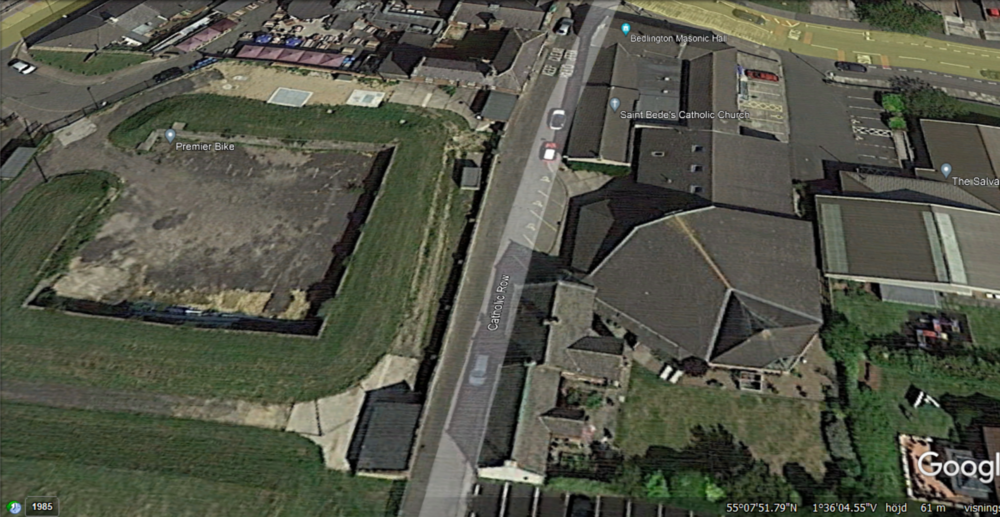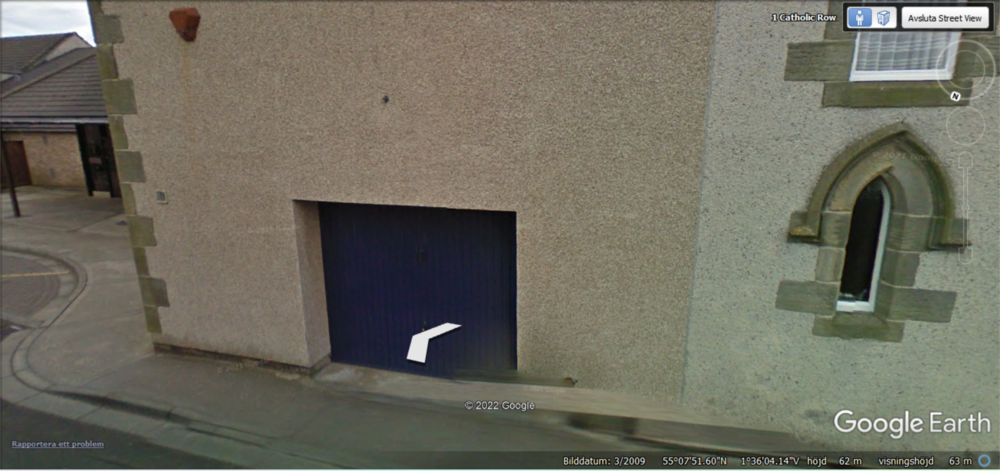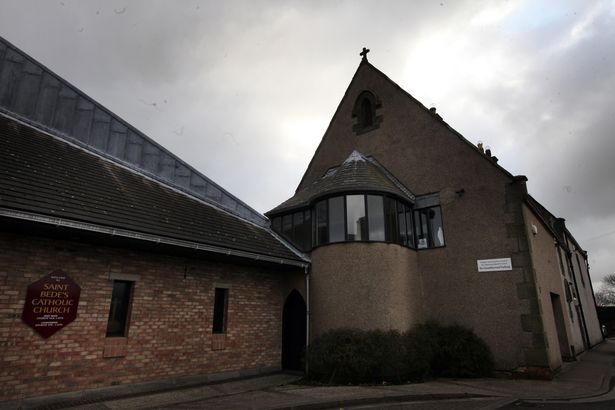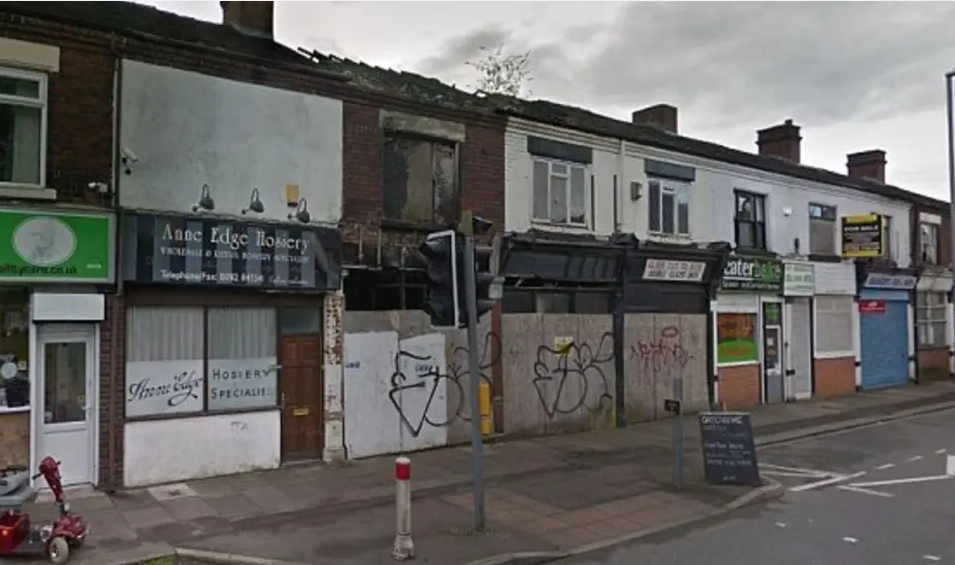.jpg.cdd7f8371d17e2f2f2e2a0e21e02f727.jpg)
Canny lass
Supporting Members-
Posts
3,596 -
Joined
-
Last visited
-
Days Won
407
Content Type
Forums
Gallery
Events
Shop
News
Audio Archive
Timeline
Everything posted by Canny lass
-
Referring back to my earlier quote: ”the 1876 sanctuary survives as the presbytery garage with a meeting room above, the original coffered roof running parallel to Catholic Row and the former ’north’ sanctuary two-light window surviving at first floor level. The rendered gable may contain the chancel arch” and relating it to the interior photo recently posted I think It’s now possible to see what’s happened to the church. What can be seen in the interior photo is the nave looking toward the chancel arch which separated the chancel from the nave (the chancel being that part of the church housing the altar, credence table and seating for the clergy. Even this area is sometimes referred to as the sanctuary). The pulpit is in the nave and to the right of the altar. Behind the pulpit is the door which leads to the sanctuary. I believe the main body of the church, the nave, has been demolished leaving the chancel and sanctuary intact. This would account for the vacant area opposite the reservoir. The quoted text suggests that the chancel arch we see in the photo may even be contained in the rendered gable. That space beyond the arch has now been converted to house the presbytery garage. Next to that garage is the two light (now only one light) window which was originally situated in the sanctuary, through the door to the right and situated behind the alter The quoted text also mentions the ”coffered roof of the sanctuary”. I had to google it but a coffered roof (ceiling would have been more helpful) consists of a series of rectangular, square or octagonal grids in three dimension sunken or recessed panels. This feature can be clearly seen just beyond the chancel arch.
-
Good lad! You're working well! Just to add to the confusion: I've just talked to a former colleague who informed me that a presbytery doesn't have to be the priest's residence. It can also be a part of a church near the altar which is reserved for clergymen. (His speciality was ecclesiastical documents so I think he probably knows what he's talking about). I never knew it had several meanings but it would locate it close to the sanctuary and the chancel arch at the gable end. Maybe it is the old church after all.
-
Maps from 1924 and 1938 show St Bedes as located parallel to Catholic Row (which is how I remember it) and exactly opposite the BUDC’s water reservoir. Google Earth 2009 shows that space as unoccupied by anything other than the narthex of the new church. I am now tempted to believe the church may have been demolished and we are looking at the former presbytery. Here are the maps and photo I’m referring to. (Re GE photo: ignore the marker for St Bedes RC Church which is wrongly placed on the Free Masons, St Cuthbert’s Lodge. If you’ve any doubts take a street view on GE and you’ll see a brass plaque on the eastern corner, St Cuthbert’s cross in every window and further stone crosses on either gable end). Eggy, perhaps there are Catholics available on other sites, who could help identify the gable end?
-
That site is quite good. I've used it a few times for other churches. However, I have to admit i found the entry for St Bede's a bit confusing. The piece I quoted refers to the garage and the meeting room above it, as well as the window, as originally being the 1876 sanctuary – in other words, part of the church. It refers to the rendered gable as possibly containing the chancel arch – also part of the church. However, if you continue reading the description of the new church which follows, its third paragraph tells us that ”the 1870s presbytery (which also contains a parish office and a first floor meeting room accessed by a circular staircase tower) is to the northwest [of the new church] along Catholic Row.” This suggests that the gable end belongs not to the church but to the presbytery - the home of the priest. The circular staircase tower is, I am presuming, that tower seen on the photo i posted from Google Earth.
-
This might be of interest. The church had its beginnings in 1875 as a mission and a school and was adapted to a church. Accommodation for a priest was added the following year. The roof of both the church and the presbytery were replaced as recently as 1970 but the concrete tiles caused structural damage leading to a decision to rebuild the church. Now the interesting bit: ”the 1876 sanctuary survives as the presbytery garage with a meeting room above, the original coffered roof running parallel to Catholic Row and the former ’north’ sanctuary two-light window surviving at first floor level. The rendered gable may contain the chancel arch.” (https://taking-stock.org.uk/building/bedlington-st-bede) Here’s a screenshot of the side of the building on Google Earth. The ’rendering’ is clearly visble in this (and the previous photo) as is the presbytery garage and ground floor window.
-
I'm not too aquainted with the RC Church in Bedlington, only that one wedding, but if this is it then it hadn't been demolished in 2009 as the picture is from Google Earth of that year. I've a vague recollection of hearing that the old church would somehow be incorporated into the new building and looking at the Google earth view this would appear to be so. It's had a facelift since the 1960s.
-
Was it this building (the gable end showing with cross at its highest poin) or am I totally mistaken? I have one picture from my sister's wedding which I believe to be taken on the corner of the building early 1960s.
-
This week i would like to know (I only managed 5 myself): Who beat Holland in the 1978 World Cup Final? In the drink ‘Gin and it’ what is ‘it’? Who was Adolf Hitler’s mistress? In which sport did Wilt Chamberlain and Alton Byrd achieve fame? Quetzel – is it animal, vegetable or mineral? In which county are all ten of England’s highest peaks? Nemesis was the Greek goddess of what? What term for a turncoat was especially applied to a Christian who turned to Islam? What is a male honeybee called? What was the title of the 1990 World Cup anthem, sung by Pavarotti? The signal ‘England expects that every man shall do his duty’? was supposedly sent before which battle What is the eigth sign of the zodiac? I’ll bet you didn’t know …. Mary Queen of Scots became Queen at the age of one week. Answers on Thursday next week. The next quiz, Good Friday, will be an Easter Special. It will also be the last quiz for this session. We have now been let out after the pandemic so I'm off on holiday shortly. The nights are lighter now and life is starting to get back to normal so on my return there are people to see and places to visit which haven't been seen/visited for a couple of years. Then there's my lovely garden which is crying out for some springtime TLC.
-
.thumb.jpg.7493ddab4a696108cf2b849323d3c155.jpg)
Hetheringtons Shoe Repairs Closing
Canny lass replied to rosco's topic in The Bedlingtonshire Consumer
The saying 'One man's meat is another man's poison' applies equally well to types of housing as to types of business on the high street. -
.thumb.jpg.7493ddab4a696108cf2b849323d3c155.jpg)
Hetheringtons Shoe Repairs Closing
Canny lass replied to rosco's topic in The Bedlingtonshire Consumer
What do you mean "will have gone back"? I've never stopped. Netherton habits die hard. -
Answers to last week's quiz: Sir Gary Sobers December 31 Sea of Marmara The Brontes Neil Young Los Angeles McCoy Air Force Base (the airport’s former name ) Apricot Millie Jackson Owl is the only character in the Winnie the Pooh books who actually lives in Hundred Acre Wood. Winnie the Pooh, and all his friends, live in the imaginary land surrounding Hundred Acre Wood. Italy Wat Tyler New quiz tomorrow.
-
.thumb.jpg.7493ddab4a696108cf2b849323d3c155.jpg)
Hetheringtons Shoe Repairs Closing
Canny lass replied to rosco's topic in The Bedlingtonshire Consumer
Rosco, am I right in thinking that you don’t consider tattoo parlours useful either? Add them to the 20 hairdressers/barbers/nail bars and beauty salons in and around the main street and that’s 23 successful small businesses giving life to the street or, to put it another way, that’s 23 (at least) employment opportunities. OK, they may not be the type of business you or I have any use for but clearly other people do. To judge the need for a business by the number of customers at any one time of day when you happen to be passing by seems a little unfair. Irrespective of the fact that there is only one customer when you happen to pass by the barbers, there may be countless at those times when you are not around. There are many businesses that have quiet and busy periods both throughout the day, the week or even the year – pubs, hairdressers and cat hotels, to name but one of each, where evenings, Friday/Saturday and summer holidays, in that order, are when income is generated. They must be doing something right if they are surviving despite the quiet periods. Correct me if I’m misunderstanding you but I am starting to get the feeling that some of your disgruntlement is because you feel that these businesses are being approved/supported/favoured by the local authority at the cost of erecting a leisure centre? Let me ask two questions – to anybody who can answer them: How many of those 23 business premises are rented from the local authority? Would a leisure centre fit into any of those premises? If the answer to the first is anywhere between 1 and 23 then those businesses are making a contribution to the coffers of the local authority – which could help to provide the longed for leisure centre rather than preventing its coming into being. If the answer to the second is no, then the small businesses are not utilising any space that could be put to use for such a leisure centre. On a lighter note: Sorry to hear the pub isn’t being built anymore but with 8-9 drinking establishments in and around the main street perhaps it’s already reached saturation point? A conundrum: Every resident in Bedlington (give or take the odd one or two who for medical reasons or otherwise doesn’t have hair, and those like Eggy who manage their own hair growth) requires the services of a hairdresser/barber from childhood through to old age. Every person in Bedlington does not require the services of a public house because it is illegal for any child younger than 16 years to drink alcohol in licensed premises (unless accompanied by an adult). With no accompanying adult the age is raised to 18 years. That’s quite a big chunk of the population who are excluded. I haven’t counted but I strongly suspect that there are at least as many licensed premises as hairdressers/barbers in Bedlington yet the former has fewer potential clients. Can anybody explain how this is possible? -
.thumb.jpg.7493ddab4a696108cf2b849323d3c155.jpg)
Hetheringtons Shoe Repairs Closing
Canny lass replied to rosco's topic in The Bedlingtonshire Consumer
I understand how you feel, Rosco. I’ve felt the same way about the number of tatoo parlours in some towns – Bedlington included. However, as long as these businesses are successfull and paying there way, we can´t say that saturation point has been reached. First when one of them goes out of business due to insufficient customers, can we say that saturation point has been reached – and then only if the remaining businesses cannot accomodate those customers because they are already working at full capacity. Saturation point for the onlooker, who is sick of the sight of them and longing for something else to take their place, is more easily reached but that’s another matter. Certainly, it would be nice if there was more variation on the street but until there are enough enterprising individuals with new ideas willing to chance the investment, AND sufficient customers who want their services, then isn’t it better with six hairdressers rather than six boarded up shop fronts? -
.thumb.jpg.7493ddab4a696108cf2b849323d3c155.jpg)
Hetheringtons Shoe Repairs Closing
Canny lass replied to rosco's topic in The Bedlingtonshire Consumer
No comment! -
.thumb.jpg.7493ddab4a696108cf2b849323d3c155.jpg)
Hetheringtons Shoe Repairs Closing
Canny lass replied to rosco's topic in The Bedlingtonshire Consumer
I am failing to see how establishing a successful business on the main street is dependent on there being a leisure centre. People who go to leisure centres go there for just that purpose – leisure. In all those which I’ve visited I have been able to buy everything I need for the purpose: leisure wear, hygiene products and bath towels (should I have forgotten to take mine along with me) as well as food and refreshments should I need/want them. I’ve even visited a hairdresser in one of them. So, as I see it, these facilities within the leisure centre (if they keep their prices down) may even kill some business that already exists on the street. Perhaps it’s being suggested that a leisure centre would attract footfall from other towns? Which towns? Morpeth? Already got one! Ashington? Already got one! Blyth? Already got one! They may visit one or two times, just to see what it’s like, but unless Bedlington’s liesure centre has some unique, gigantic, ’can’t be lived without’ magnet of a special attraction they’ll soon realise that they can have the same experience, without travel time and costs, on their own doorstep. Most of the arguments I’ve read in previous topics related to wanting a leisure centre in Bedlington have revolved around just that question – the need to avoid travel. Eggy, as long as Bedlington’s high street has its business premises occupied and in use – with whatever – then I would say it IS thriving. If it wasn’t it would look like the Nottingham street in the photo above. As Vic points out, ’business’ doesn’t need to be a shop. For me, and I suspect many others, where I do my weekly shopping is not just a question of its cheaper prices that makes me choose a supermarket. It’s also the time and the effort that would be involved should i choose to shop in small specialized grocery shops. I could never go back to my mother’s way of shopping; 2-3 times a week (morning or afternoon only and no Sunday opening), carrying increasingly heavy shopping bags from one shop to another, waiting in a queue in EVERY shop then waiting for the item to be wrapped (no pre-packed veg.) then lugging them all the way home in time for the kids coming home from school. A half day’s work at best. No thank you! Much better with once a week, one stop - preferably on the way home from work (or the leisure centre when I’m out and about anyway), shopping trolley instead of heavy bags (no carrying), one queue at the checkout then trolley to the car park. An hour and a half at the very most. It would be interesting to hear just what would be considered ’useful’ and at the same time able to be accomodated in any of the small business premises on Bedlington’s high street, should they become vacant. -
.thumb.jpg.7493ddab4a696108cf2b849323d3c155.jpg)
Hetheringtons Shoe Repairs Closing
Canny lass replied to rosco's topic in The Bedlingtonshire Consumer
Sorry! wrong quote! I must get new specs! -
.thumb.jpg.7493ddab4a696108cf2b849323d3c155.jpg)
Hetheringtons Shoe Repairs Closing
Canny lass replied to rosco's topic in The Bedlingtonshire Consumer
I wasn't meaning that local councils should be playing big brother, Vic, more that they should be looking at the impact of the business on the infrastructure and amenities available: roads, traffic, parking facilities, schools, in the vicinity and so on. I think it's worth them looking at what type and where the new businesses are planned to see whether or not they fit in with existing town planning or if amendments needed to be made. Are there parking spaces? Will pedestrians cause problems? Will the business cause problems for pedestrians? Could there be traffic problems? Is the nature of the business suitable for the area? (here, you'd never be allowed to put an Ann Summers shop (are they still in existence) near a school and plans are even afoot to prevent sweets and energy drinks being sold near schools). -
.thumb.jpg.7493ddab4a696108cf2b849323d3c155.jpg)
Hetheringtons Shoe Repairs Closing
Canny lass replied to rosco's topic in The Bedlingtonshire Consumer
Twenty years ago I, and many women like me, enjoyed a day in the town, trailing around the shops looking for a bargain and despite the unavoidable sore feet and inevitable clock-watching (couldn’t afford to miss the 4 o’ clock bus home because the old man would be wanting his tea) this was, believe it or not, considered to be a relaxing day out! ”Go and enjoy yourself” my OH said, quite seriously, and I did! Now I, and many like me, think it’s much more relaxing to sit in a comfy sofa, lap-top on knee, G&T in hand and find my requirements without the sore feet and clock-watching. It also has the added benefits of non existent travel/parking costs, time saved and being able to shop when I want rather than when the shops are open. I certainly agree with you that local authorities need to adapt to new life styles and how to put disused buildings to use. However, I don’t know just how much of Bedlington Front Street, if any, is council owned. I do think they ought to be able to approve, or disapprove, new businesses even in private properties but then comes the dilemma: Should we allow another hairdresser etc. to open shop or should we say no and let the property stand empty. The latter doesn’t look too good in any town and the former gives an employment opportunity(even if it’s only for the owner) and keeps the street alive. If hairdressers etc are succeeding there must be a need for them. -
.thumb.jpg.7493ddab4a696108cf2b849323d3c155.jpg)
Hetheringtons Shoe Repairs Closing
Canny lass replied to rosco's topic in The Bedlingtonshire Consumer
Rosco, I hear what you're saying and I understand that you are disgruntled with what’s on offer in Bedlington but the very fact that there are so many surviving small businesses in just those categories (hairdressers, barbers, nail bars and beauty salons) is in fact proof that they are meeting the needs and requirements of the Bedlington populace and as such must be deemed as being useful. They would have gone bankrupt long ago if they were not. Clearly, this type of business isn’t anything that appeals to you – and, if I’m honest, three of them don’t appeal to me either – however, as Eggy and Pete very accurately outline above, shopping/selling patterns have moved with the times and services of many kinds are now only a text message away. Unless Bedlington high street has changed dramatically during the past few years the businesses which you are deeming to be of no use occupy small premises not suitable for the retailing giants. They are therefore reliant on small businesses for their use. Such premises also bring with them costs for rent, heating, lighting and water so it’s not surprising that many hairdressers, barbers, nailbars and beauty salons today choose to be ”a text message away” and go to the customer’s home instead of having the customer come to them. Shouldn’t we therefore be thankful that there are still people willing to occupy these small premises in Bedlington because without them – whatever their line of business – this is what Bedlington would look like today: -
.thumb.jpg.7493ddab4a696108cf2b849323d3c155.jpg)
Hetheringtons Shoe Repairs Closing
Canny lass replied to rosco's topic in The Bedlingtonshire Consumer
Only a matter of time! In the larger towns here, robots have already replaced bike messengers for delivering, ready to eat meals. They are also being tried out for delivering, groceries and packages. I can't agree with Rosco that hairdressers and barbers don't fall into the category 'useful' but I do agree that Bedlington women have no need for beauty parlours. They are just perfect as they are. -
A bit late, but we've been let out today, watching Cranes doing their mating dance - all 18 000 of them! No more restrictions so we've decided to make the most of it before they come back - which they almost certainly will. If you'd like to see our yearly invasion of Cranes it's also live streamed here: http://www.webbkameror.se/djurkameror/hornborgasjon/hornborgasjon_1_live.php (Choose 'Djurkameror' from the menu). The quiz: Which cricketer was the first to hit six sixes in an over? Jack had his second birthday yesterday and he’ll be 4 years old next year. What is the date of Jack’s birthday? Which sea lies between the Bosporus and the Dardanelles? Which literary family lived at Haworth in Yorkshire? Who recorded the albums After the Goldrush and Harvest? In which city did the summer Olympic Games of 1984 take place? Orlando International Airport has the location code ‘MCO’. What do these letters stand for? Alfred, Farmingdale and Pixy are all types of what? Who sang with Elton John on Act of War? Who lives in Hundred Acre Wood? In which country was Florence Nightingale born? Who led the Peasant’s Revolt of 1381? I’ll bet you didn’t know …. The onion is the most widely used vegetable in the world. Answers on Thursday next week.
-
Answers to last week's quiz: Zeus* (½ point to those who answered Uranus. See note below) 1944 M90 Sir Edwin Landseer Mildew A young hawk (especially one taken early from the nest for training) 3 minutes Guadalcanal Hinny Monopoly Dr Christiaan Barnard Somalia New quiz tomorrow. * I also answered Uranus but the correct answer is Zeus. Uranus is primarily known as the God of the heavens. However, he was also, but only for a very short while, the King of the Gods, and therefore ruler of the universe (including the earth). He was a nasty piece of work who refused to let any of his 18 children leave their mother’s womb (imagine that if you can!). His perpetually pregnant and long-suffering wife, Gaea, must have been well fed up with the situation. She plotted with one of the captive sons, Cronos, who castrated his father with a sickle while said father was attempting to excercise his conjugal rights, thus bringing about his downfall. However, it is Zeus, the son of the sickle wielding Cronos, who became, and remained, the Supreme Ruler of the Universe and therefore of the heavens and the earth. Amazingly, Zeus was the only child of Cronos who managed to escape being eaten by his father at birth and that because his mother handed a baby-sized stone, wrapped in swaddling clothes to the famished Cronos who duly ate it, presumably without unwrapping it. I understand that he later spewed the stone up and Zeus set it into a path near Parnassos (I may have walked on it during my travels)! You really couldn’t make this up, could you!








